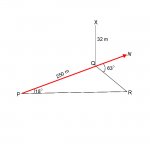IloveManUtd
New member
- Joined
- Jul 27, 2010
- Messages
- 48
The points P, Q and R are on level ground such that Q is due north of P. The bearing of R from P is 018[sup:mloc695q]o[/sup:mloc695q] and the bearing of R from Q is 063[sup:mloc695q]o[/sup:mloc695q]. Given that the vertical post XQ is 32m, and that the length of PQ is 250m, calculate the angle of elevation of X from P?
I do not understand the question and am wondering how the answer my book gives is 7.3[sup:mloc695q]o[/sup:mloc695q]. Please help. Thx
I do not understand the question and am wondering how the answer my book gives is 7.3[sup:mloc695q]o[/sup:mloc695q]. Please help. Thx

